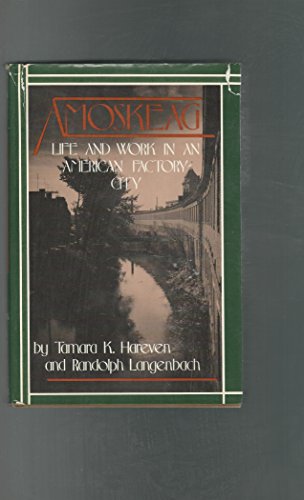Randolph Langenbach
TO LISTEN TO A LECTURE BY RANDOLPH LANGENBACH ABOUT HIS LATEST BOOK, ON THE "AUTHOR'S PAGE," CLICK ON THE ARROW ON THE RECTANGLE ON THE RIGHT OF THIS BIOGRAPHY, UNDER "AUTHOR UPDATES."
Randolph Langenbach first became known as a documentary photographer and writer because of his work documenting the textile mill towns of New England and landscapes of the Industrial Revolution in Great Britain. His groundbreaking work on the Amoskeag Mills in Manchester N.H. resulted in a series of exhibitions and the book, Amoskeag, Life and Work in an American Factory City, co-authored with Tamara Hareven, published in 1978 and has remained continuously in print for over 35 years. Later, his exhibition in England at the Royal Institute of British Architects, and the companion book Satanic Mills, published by SAVE Britain’s Heritage, contributed to changes in British government policy away from systematic demolition of historic 19th Century textile mills.
Langenbach’s educational background is both in Architecture and in Building Conservation, with degrees from Harvard College and Harvard Graduate School of Design in the United States and the Institute of Advanced Architectural Studies in York, England. During the time of his independent work on the textile mill towns, he worked as a consultant in historic preservation planning and design in New England, and later in the San Francisco Bay Area. This included work on the National Historical Park in the planned industrial town of Lowell, Massachusetts, among other projects.
From 1984 to 1991, he was Assistant Professor of Architecture at the University of California, Berkeley where he began his research project to investigate the seismic vulnerability and methodologies for the strengthening of historic masonry buildings. In 1992, he began work for the Federal Emergency Management Agency (FEMA) as a consultant on the Loma Prieta Earthquake recovery operations in California, and later promoted to Senior Analyst at FEMA Headquarters in Washington DC.
In 2002, he was awarded the National Endowment for the Arts Rome Prize Fellowship in Historic Preservation at the American Academy in Rome both for his photography, and for his publications on traditional earthquake-resistant construction in different countries around the world. He simultaneously also was appointed as a Fellow of ICCROM. During that year, he undertook research on the damage and recovery operations after the earthquake in Molise, Italy, and also received a grant from the Earthquake Engineering Research Institute (EERI) to continue research in Turkey. Also, while at the Academy, he produced the slide/video The Piranesi Project, A Stratigraphy of Views of Rome which has achieved special recognition from the City of Rome Department of City Planning, and which also received acclaim when shown in London at the Sir John Soane Museum. Since then, he has produced a film from this project named Rome Was! Ruins Eternal, and he is also in the process of producing a book named Rome Was! The Eternal City from Piranesi to the Present to be published by ORO Editions in April 2019.
His research on the conservation of masonry buildings in earthquake areas was first inspired by his work on the vast brick and stone New England textile factories which withstood the intense vibrations of the looms for over a century. After suffering the devastating setback of the loss of almost all of his prior work as a writer and photographer when his home was destroyed in the 1991 Oakland Firestorm, he resumed this project with the investigation of the traditional Ottoman construction that survived the two 1999 earthquakes in Turkey that devastated thousands of reinforced concrete buildings of more recent vintage. More recently, his work has been focused primarily on buildings of traditional construction in Kashmir, India, Yugoslavia, Greece, Central America, and most recently, in Nepal, where he and his work was featured in the PBS NOVA Science documentary Himalayan Megaquake in 2016.
Over the last two decades, he has served as a consultant on this subject to UNESCO in Turkey, Georgia, India and Iran; to the World Monuments Fund in Iran and Haiti; to UN-HABITAT in Pakistan after both the 2005 earthquake and the 2010 floods; and to the Turquoise Mountain Foundation in Afghanistan. During these assignments, he has documented the damage to historical structures in India from the Bhuj (Gujarat) Earthquake of 2001, the 2002 earthquake in Tbilisi, Georgia, the 2003 Bam, Iran earthquake, and the 2005 earthquake in Kashmir. He has been an invited keynote and plenary speaker at over 35 conferences in almost as many countries around the world including most recently at the World Conference on Timber Engineering in Quebec City and the 3rd UN World Conference on Disaster Risk Management in Japan. He also has been an invited speaker at TEDx in Manchester, N.H. the World Bank, the British Institution of Structural Engineers, Cambridge and Oxford Universities, and other venues.
He has published numerous works on the subject of traditional earthquake resistant construction, and, in 2009, UNESCO published his book Don’t Tear It Down! Preserving the Earthquake Resistant Vernacular Architecture of Kashmir. This book has been re-published in the USA and the UK and is now in print. He is a co-author of Preserving Haiti’s Gingerbread Houses, published by the World Monuments Fund in 2010, which is available online by WMF through a link at www.conservationtech.com.
His published and other creative work can be found at www.conservationtech.com and www.traditional-is- modern.net, and his movie and art exhibition and writings on Rome can be found at www.piranesian.com.
Popular items by Randolph Langenbach
View all offers-
Amoskeag: Life and Work in an American Factory City
Hareven, Tamara K.
Item prices starting from
View 76 offersUS$ 5.97
-
Don't Tear It Down! Preserving the Earthquake Resistant Vernacular Architecture of Kashmir
Langenbach, Randolph
Item prices starting from
View 18 offersUS$ 37.29

